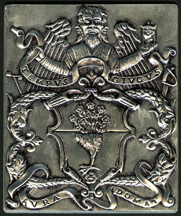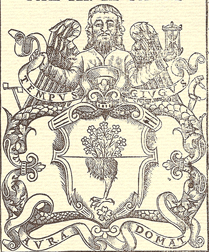SIDNEY M. EDELSTEIN AWARD FOR OUTSTANDING ACHIEVEMENT IN THE HISTORY OF CHEMISTRY
Plaque Description
The Sidney M. Edelstein Award plaque consists of 4 parts:
- A felt backed wooden board painted black 12" x 9"
- Using a bronze mold a pewter plate 3.5" x 3" is cast.
The design, in relief, is a copy of the design on the frontispiece
of the Plicto de Larte de Tentori che Insegna Tenger Pani Telle Banbasi et Sede si per Larthe Magiore come per las Comune by Gioanuentura Rosetti, published in Venice in 1548. Sidney M. Edelstein and Hector C. Borghetty published a translation of the 1548 edition (The Plichto of Gioaventura Rosetti Instructions in the Art of the Dyers which Teaches the Dyeing of Woolen Cloths, Linens, Cottons, and Silk by the Great Art as Well as by the Common MIT Press, 1969). In the Introduction they state "Rosetti's Plichto is the first basic printed book on dyeing."
 Plate from Edelstein Award plaque
Plate from Edelstein Award plaque Frontispiece from Plichto(1548)
Frontispiece from Plichto(1548)
showing only the relevant image - A pewter plate 5” x .625’ x .093”. The name of the award is hand engraved on it.
- A pewter plate 4” x 4.5” x .125” hand engraved with the recipient’s name and an explanation of the nature of the award and the name of the presenter.
Sidney Edelstein wished that the award look old fashioned hence the handwork. No machine engraving is used.
An image of the award presented to Anthony Travis, the 2007 Edelstein Award Winner. We thank him for scanning the plaque for us.
Cedric Bannister, of Turner Falls, MA, has supplied this award for over 35 years.
